BMW 2007 Annual Report Download - page 219
Download and view the complete annual report
Please find page 219 of the 2007 BMW annual report below. You can navigate through the pages in the report by either clicking on the pages listed below, or by using the keyword search tool below to find specific information within the annual report.-
 1
1 -
 2
2 -
 3
3 -
 4
4 -
 5
5 -
 6
6 -
 7
7 -
 8
8 -
 9
9 -
 10
10 -
 11
11 -
 12
12 -
 13
13 -
 14
14 -
 15
15 -
 16
16 -
 17
17 -
 18
18 -
 19
19 -
 20
20 -
 21
21 -
 22
22 -
 23
23 -
 24
24 -
 25
25 -
 26
26 -
 27
27 -
 28
28 -
 29
29 -
 30
30 -
 31
31 -
 32
32 -
 33
33 -
 34
34 -
 35
35 -
 36
36 -
 37
37 -
 38
38 -
 39
39 -
 40
40 -
 41
41 -
 42
42 -
 43
43 -
 44
44 -
 45
45 -
 46
46 -
 47
47 -
 48
48 -
 49
49 -
 50
50 -
 51
51 -
 52
52 -
 53
53 -
 54
54 -
 55
55 -
 56
56 -
 57
57 -
 58
58 -
 59
59 -
 60
60 -
 61
61 -
 62
62 -
 63
63 -
 64
64 -
 65
65 -
 66
66 -
 67
67 -
 68
68 -
 69
69 -
 70
70 -
 71
71 -
 72
72 -
 73
73 -
 74
74 -
 75
75 -
 76
76 -
 77
77 -
 78
78 -
 79
79 -
 80
80 -
 81
81 -
 82
82 -
 83
83 -
 84
84 -
 85
85 -
 86
86 -
 87
87 -
 88
88 -
 89
89 -
 90
90 -
 91
91 -
 92
92 -
 93
93 -
 94
94 -
 95
95 -
 96
96 -
 97
97 -
 98
98 -
 99
99 -
 100
100 -
 101
101 -
 102
102 -
 103
103 -
 104
104 -
 105
105 -
 106
106 -
 107
107 -
 108
108 -
 109
109 -
 110
110 -
 111
111 -
 112
112 -
 113
113 -
 114
114 -
 115
115 -
 116
116 -
 117
117 -
 118
118 -
 119
119 -
 120
120 -
 121
121 -
 122
122 -
 123
123 -
 124
124 -
 125
125 -
 126
126 -
 127
127 -
 128
128 -
 129
129 -
 130
130 -
 131
131 -
 132
132 -
 133
133 -
 134
134 -
 135
135 -
 136
136 -
 137
137 -
 138
138 -
 139
139 -
 140
140 -
 141
141 -
 142
142 -
 143
143 -
 144
144 -
 145
145 -
 146
146 -
 147
147 -
 148
148 -
 149
149 -
 150
150 -
 151
151 -
 152
152 -
 153
153 -
 154
154 -
 155
155 -
 156
156 -
 157
157 -
 158
158 -
 159
159 -
 160
160 -
 161
161 -
 162
162 -
 163
163 -
 164
164 -
 165
165 -
 166
166 -
 167
167 -
 168
168 -
 169
169 -
 170
170 -
 171
171 -
 172
172 -
 173
173 -
 174
174 -
 175
175 -
 176
176 -
 177
177 -
 178
178 -
 179
179 -
 180
180 -
 181
181 -
 182
182 -
 183
183 -
 184
184 -
 185
185 -
 186
186 -
 187
187 -
 188
188 -
 189
189 -
 190
190 -
 191
191 -
 192
192 -
 193
193 -
 194
194 -
 195
195 -
 196
196 -
 197
197 -
 198
198 -
 199
199 -
 200
200 -
 201
201 -
 202
202 -
 203
203 -
 204
204 -
 205
205 -
 206
206 -
 207
207 -
 208
208 -
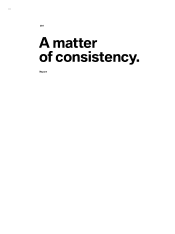 209
209 -
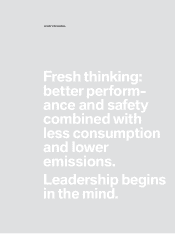 210
210 -
 211
211 -
 212
212 -
 213
213 -
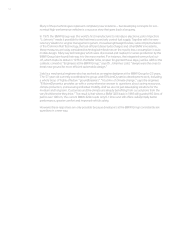 214
214 -
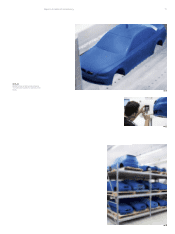 215
215 -
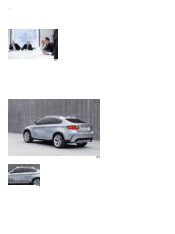 216
216 -
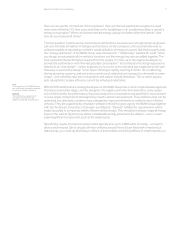 217
217 -
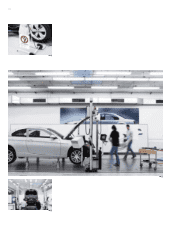 218
218 -
 219
219 -
 220
220 -
 221
221 -
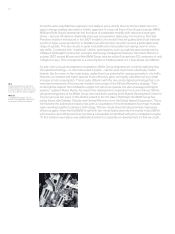 222
222 -
 223
223 -
 224
224 -
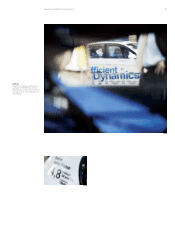 225
225 -
 226
226 -
 227
227 -
 228
228 -
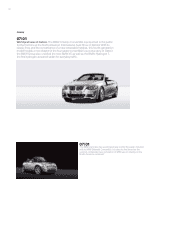 229
229 -
 230
230 -
 231
231 -
 232
232 -
 233
233 -
 234
234 -
 235
235 -
 236
236 -
 237
237 -
 238
238 -
 239
239 -
 240
240 -
 241
241 -
 242
242 -
 243
243 -
 244
244 -
 245
245 -
 246
246 -
 247
247
 |
 |
19
== 1
Tyres with less roll resistance
are especially fuel-efficient, owing
to reduced strain on tread and
sidewalls.
== 2 – 3
Preparations for flow and circu-
lation
testing of the engine com-
partment in the wind tunnel.
Report: A matter of consistency.
This is where the BMW Group’s engineers come in: their electric water pump only switches on when it
is actually needed – and for that it only needs the energy of two bright light bulbs. This technology,
which was driven largely by the BMW Group (and still the only auto manufacturer in the world to use it)
currently saves two percent of fuel in the automobile.
In this way – segment by segment, component by component – the engineers scour all models for
potential economies: engineering minor revolutions such as highly-efficient Brake Energy Regeneration
and the jet-guided direct fuel injection system that result in consumption figures which only used to be
possible for diesel engines; optimising small things such as air flaps which open or close on their own
depending on the engine’s cooling requirements; designing a detachable air conditioning compressor
which only springs into action when it really needs to cool; drastically reducing the roll resistance of
tyres and replacing conventional hydraulic steering with much more economical electric steering. In
the meantime, all of these features are standard in almost all models of the BMW and MINI brands.
Many of them seem so obvious that one has to wonder why they were not implemented long ago. The
reason is that these apparently simple solutions often conceal extremely complex technologies. Just
how complex can be seen from the example of the ASSF.
ASSF stands for Auto Start Stop Function and is the most radical approach to throttling engine
con-
sumption since it cuts off the engine immediately once it is no longer needed. A small number
of
automobile manufacturers tried automatic engine stop functions years ago, but they were quickly
withdrawn from the market because they were too cumbersome, too unreliable, and, as a result,
ineffective. However, engineers at the BMW Group knew from simulations and trial runs that switching
off and restarting the drive train for state-of-the-art injection engines pays off after just a few seconds’
standing time. A red traffic light lasts on average about 20 seconds. That made us realise that there
were huge potential savings to be discovered here, one developer remembers. What we didn’t
realise at the outset was how much work would be involved in successfully harnessing that potential.
